Leep Procedure
Services: Testing
Leep Procedure
Your health care professional may suggest that you have a loop electrosurgical excision procedure (LEEP) as part of the evaluation or treatment for Cervical Cancer Screening.
Your doctor may recommend this procedure if they notice changes to your cervix during a pelvic exam or if your Pap test results are abnormal. Abnormal cells could be benign growths (polyps), or they could be precancerous.
If left untreated, precancerous cells may develop into cervical cancer.

Leep Procedure
What is a Loop Electrosurgical Excision Procedure (LEEP), and why is it done?
Suppose you have an abnormal cervical cancer screening result. Your health care professional may suggest that you have a loop electrosurgical excision procedure (LEEP) as part of the evaluation or treatment (see the FAQ085 Cervical Cancer Screening). LEEP is one way to remove abnormal cells from the cervix using a thin wire loop like a scalpel (surgical knife). An electric current is passed through the loop, which cuts away a thin layer of the cervix.
Who gets this procedure?
Your doctor may recommend this procedure if they notice changes to your cervix during a pelvic exam or if your Pap test results are abnormal. Abnormal cells could be benign growths (polyps), or they could be precancerous. If left untreated, precancerous cells may develop into cervical cancer. Removing the cells will allow your doctor to determine what they are and whether further observation or treatment is needed. Your doctor may also order a LEEP to diagnose and treat genital warts. Genital warts can indicate human papillomavirus (HPV), and HPV can increase your risk of developing cervical cancer.
If you have a pelvic inflammatory disease or acute cervix inflammation, your doctor may advise against a LEEP. A cone biopsy, which is done surgically, might be better for you. Some doctors will recommend a laser procedure (or cryotherapy) where the area of concern is frozen and subsequently dies and sloughs off.
How is LEEP performed?
A LEEP should be done when you do not have your menstrual period to better view the cervix. In most cases, LEEP is done in a health care professional’s office. The procedure only takes a few minutes.
You will lie on your back and place your legs in stirrups during the procedure. The health care professional will then insert a speculum into your vagina in the same way as a pelvic exam. Local anesthesia will be used to prevent pain. It is given through a needle attached to a syringe. You may feel a slight sting, then a dull ache or cramp. The loop is inserted into the vagina to the cervix. There are different sizes and shapes of loops that can be used. You may feel faint during the procedure. If you feel faint, tell your health care professional immediately.
After the procedure, a special paste may be applied to your cervix to stop any bleeding. Electrocautery also may be used to control bleeding. The removed tissue will be studied in a lab to confirm the diagnosis.
Are there any risks?
LEEP is safe and effective. There are just a few risks.
Risks can include:
- Infection
- Bleeding during or after the procedure (though the tool helps seal the surrounding blood vessels to minimize this risk)
- Scarring on the cervix depending on the amount of tissue the doctor needs to remove
- Difficulty getting pregnant in the year after the procedure
Our entire team is dedicated to you
We Help You Navigate Healthcare Decisions With Confidence
We Have Decades of Medical Experience and Providing Compassionate Care.

TEstimonials
What Our Patients Say
What an exceptional experience! I have never been to a nicer medical office. Ever! I was let called in after a second of completing my check in and everyone was so very nice. I wish i knew the name of the assistant that answered all our questions, she was very nice and informative. Don’t hesitate ladies!
The staff and everyone I met on the care team were extremely warm, kind, and knowledgeable. Although visit times are short, they made sure to explain everything thoroughly and made sure I understood. Even though they spoke quickly (lots of info to share in a short 15 minute slot) I never felt rushed or dismissed. I highly recommend this location and especially Dawn.

